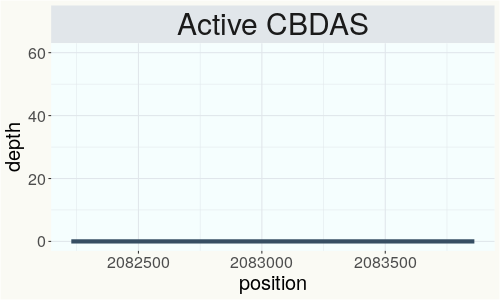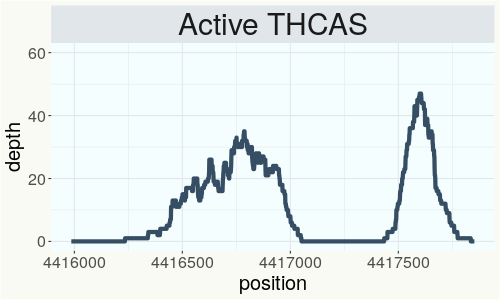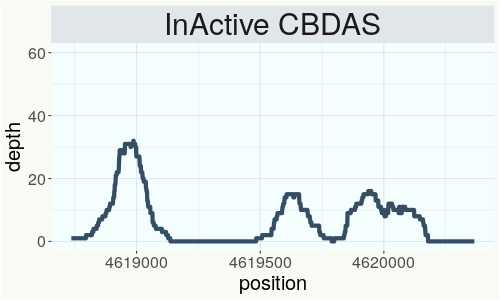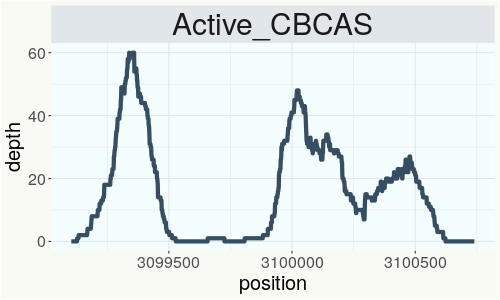Hermaphrodite_Research_Sample1
RSP 11042
Grower: Iron Laboratories
General Information
- Accession Date
- December 18, 2017
- Reported Plant Sex
- not reported
- Report Type
- StrainSEEK v2 3.2Mb
- DNA Extracted From
- Stem
The strain rarity visualization shows how distant the strain is from the other cultivars in the Kannapedia database. The y-axis represents genetic distance, getting farther as you go up. The width of the visualization at any position along the y-axis shows how many strains there are in the database at that genetic distance. So, a common strain will have a more bottom-heavy shape, while uncommon and rare cultivars will have a visualization that is generally shifted towards the top.
Chemical Information
Cannabinoid and terpenoid information provided by the grower.
Cannabinoids
No information provided.
Terpenoids
No information provided.
Genetic Information
- Plant Type
- Type I
File Downloads
The bell curve in the heterozygosity visualization shows the distribution of heterozygosity levels for cannabis cultivars in the Kannapedia database. The green line shows where this particular strain fits within the distribution. Heterozygosity is associated with heterosis (aka hybrid vigor) but also leads to the production of more variable offspring. When plants have two genetically different parents, heterozygosity levels will be higher than if it has been inbred or backcrossed repeatedly.
The ratio of reads mapped to Y-contigs to reads mapped to the whole Cannabis genome (Y-ratios) has been demonstrated to be strongly correlated with plant sex typing. This plot shows the distribution of Y-ratios for all samples in our database which were sequenced with the same method (panel or WGS) as this sample and where this sample falls in the distribution.

This chart represents the Illumina sequence coverage over the Bt/Bd allele. These are the three regions in the cannabis genome that impact THCA, CBDA, CBGA production. Coverage over the Active CBDAS gene is highly correlated with Type II and Type III plants as described by Etienne de Meijer. Coverage over the THCA gene is highly correlated with Type I and Type II plants but is anti-correlated with Type III plants. Type I plants require coverage over the inactive CBDA loci and no coverage over the Active CBDA gene. Lack of coverage over the Active CBDA and Active THCA allele are presumed to be Type IV plants (CBGA dominant). While deletions of entire THCAS and CBDAS genes are the most common Bt:Bd alleles observed, it is possible to have plants with these genes where functional expression of the enzyme is disrupted by deactivating point mutations (Kojoma et al. 2006).



This chart represents the Illumina sequence coverage over the CBCA synthase gene.

Variants (THCAS, CBDAS, and CBCAS)
No variants to report
Variants (Select Genes of Interest)
| PKSG-2a | c.67T>A | p.Phe23Ile | missense variant | moderate | contig700 | 1945567 | A/T | |
| PKSG-2a | c.31A>T | p.Thr11Ser | missense variant | moderate | contig700 | 1945603 | T/A | |
| PKSG-2b | c.1152T>A | p.Asn384Lys | missense variant | moderate | contig700 | 1950486 | A/T | |
| PKSG-2b | c.1132C>G | p.Leu378Val | missense variant | moderate | contig700 | 1950506 | G/C |
|
| PKSG-2b | c.1117A>G | p.Ile373Val | missense variant | moderate | contig700 | 1950521 | T/C | |
| PKSG-2b | c.31A>T | p.Thr11Ser | missense variant | moderate | contig700 | 1951851 | T/A | |
| PKSG-4b | c.496A>G | p.Lys166Glu | missense variant | moderate | contig700 | 2721177 | T/C | |
| PKSG-4b | c.489delT | p.Phe163fs | frameshift variant | high | contig700 | 2721183 | CA/C | |
| PKSG-4b | c.485A>G | p.Lys162Arg | missense variant | moderate | contig700 | 2721188 | T/C | |
| aPT1 | c.406A>G | p.Ile136Val | missense variant | moderate | contig121 | 2839605 | A/G | |
| HDS-2 |
c.82_93delGT |
p.Val28_Thr3 |
conservative inframe deletion | moderate | contig95 | 1989748 |
CGTAACCGGAAC |
|
Nearest genetic relatives (All Samples)
- 0.002 Bordello (RSP11228)
- 0.004 Hermaphrodite Research Sample1 (RSP11049)
- 0.145 RKM-2018-018 (RSP11110)
- 0.167 Blue Dream (RSP11009)
- 0.175 Blue Dream (RSP11017)
- 0.178 Blue Dream (RSP11010)
- 0.180 Blue Dream (RSP11004)
- 0.186 Sour D (RSP11343)
- 0.187 Blue Dream (RSP11008)
- 0.187 Blue Dream (RSP11007)
- 0.188 Serious Happiness (RSP10763)
- 0.188 TI (RSP11149)
- 0.189 Blue Dream (RSP11006)
- 0.196 Blue Dream (RSP11012)
- 0.199 OR 05MAY2017 (RSP10940)
- 0.200 Rest (RSP11377)
- 0.201 JL Cross 13 (RSP11514)
- 0.202 East Coast Sour Diesel (RSP10243)
- 0.205 Domnesia (RSP11184)
- 0.206 Super Blue Dream (RSP11011)
Most genetically distant strains (All Samples)
- 0.490 Cherry Blossom (RSP11311)
- 0.481 Cherry Blossom (RSP11328)
- 0.455 Cherry Blossom (RSP11314)
- 0.451 Cherry Blossom (RSP11334)
- 0.449 Cherry Blossom (RSP11309)
- 0.446 Unknown--Cherry Wine---001- (RSP11268)
- 0.442 Unknown--Cherry Wine---003- (RSP11270)
- 0.442 Cherry Blossom (RSP11298)
- 0.440 Cherry Blossom (RSP11312)
- 0.438 Cherry Blossom (RSP11300)
- 0.437 Tiger Tail -30- (RSP11484)
- 0.436 Unknown--Cherry Wine---002- (RSP11269)
- 0.432 80E (RSP11213)
- 0.425 Cherry Blossom (RSP11333)
- 0.424 Cherry Blossom (RSP11317)
- 0.423 Northern Skunk (RSP11456)
- 0.421 JL 3rd Gen Father (RSP11196)
- 0.420 80E (RSP11211)
- 0.417 Cherry Blossom (RSP11335)
- 0.416 Cherry Blossom (RSP11308)
Nearest genetic relative in Phylos dataset
- Overlapping SNPs:
- 120
- Concordance:
- 114
Nearest genetic relative in Lynch dataset
- Overlapping SNPs:
- 3
- Concordance:
- 3
Blockchain Registration Information
- Transaction ID
-
1c0fdcbaa449bd22
411173831aecbab6 f3567bfed97b4fb6 3159e122be5b31eb - Stamping Certificate
- Download PDF (852.0 KB)
- SHASUM Hash
-
b91e36b3de9cd286c5dc7c453073bc54 ee36cda66e1d3197 778443ee99c69ca6